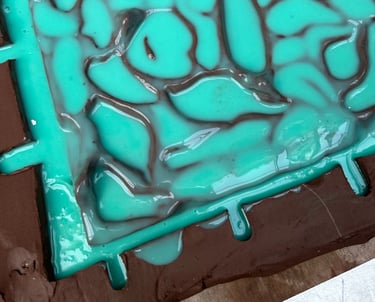Fragility and Time
Fragility is not a mood here. It is a method. Silicon moulds carry depth precisely because they are almost not there. Haze holds light more convincingly than perfect clarity. Clay edges chip and record the passing of drying air. On the relief plates, glaze is allowed to pool in the valleys while high points remain dry, so a slow shadow carries depth instead of gloss. Time becomes legible at the scale of micro pits, faint seams and tiny shifts of tone. An early critique asked me to stop polishing these signs. Once I left gloss to pool in valleys and allowed a chalky edge to remain, the works spoke with more clarity. They asked the viewer to slow down.


This also clarifies my drawing position. I am not illustrating fragility on a page; drawing operates as a spatial condition made by field, seam and spacing in the room, so that measured gaps read as lines the body can follow (Krauss 1979). A brief visual analysis from the studio: in the porcelain ripple that fractured during drying, the thinnest crests opened first, yet when fragments are placed on sand the ripple still reads across the breaks; the eye tracks flow through absence as well as mass. On the field of plates, the even seam reads before the object under raking light, so drawing is the structure rather than a finish.
Earlier paintings already taught me that translucency can carry mood through time. That lesson returns now as a slight veil in thin silicon moulds where depth reads as shallow water rather than shine. The small shift from glossy reflection toward soft depth is decisive.
Gavin described the MA show installation as a careful orchestration that moves from a drawn line into sculptural forms and that speaks of loss and melancholy. He recognised that the practice is formed from broken elements and that creation here often grows from destruction. His reading helped me accept fragility as the right tempo for this subject. It is not a weakness. It is an accurate register for work about residue and memory, and it aligns with practices that keep process and precarity active in space (Temkin 2002), with readings of Duchamp’s Large Glass where cracking is accepted as meaning (Tomkins 1996), and with accounts of absence and surface as carriers of memory (Dexter 2005).
monayadav.com